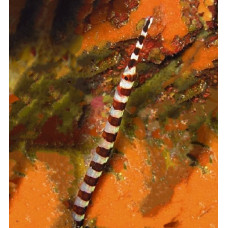Latin name
Dunckerocampus boylei
Other name
Dunckerocampus boylei
Identification
The species name is in honor of Bill Boyle, an underwater photographer who brought the species to Kuiter's attention.
The Broad-banded Pipefish has an elongated, slender body. The head has a tubular snout. The tail is long and can be used to attach itself to aquatic plants and objects.
Features of fish fins
Dorsal soft rays (total): 21; Anal soft rays: 4. Pelvic fins are absent.
Fish colouring
Broad-banded Pipefish have broad stripes and a distinctive tail fin pattern.
Distribution
Occupies the Red Sea, Mauritius and Indonesia, but is thought to be widespread throughout the Indian Ocean.
Habitat
A deep-sea benthic species. Its depth range is 20-40 meters.
Size
Can grow to a length of 16 centimeters (6.3 inches).
Behavior
Non-migratory fish. They live alone or in pairs in coastal caves and crevices. Adults prefer depths of about 25 m or more and are easy to miss.
Food and feeding habits
Feeds on small crustaceans that grow on other fish species.
Reproduction
This is an egg-laying species. The male lays eggs in a brood pouch under the tail.
Fishing
The species is of minor commercial interest.
Relationship with a person
Harmless.
| Classification | |
| Phylum | Chordata |
| Class | Actinopterygii |
| Squad | Syngnathiformes |
| Family | Syngnathidae |
| Genus | Dunckerocampus |
| Species | D. boylei |
| Features | |
| Conservation status | Least Concern |
| Habitat | Bottom |
| Life span, years | No information |
| Maximum body weight, kg | No information |
| Maximum length, cm | 16 |
| Sailing speed, m/s | No information |
| Threat to people | Edible |
| Way of eating | Planktonophage |
Broad-banded Pipefish
Tags: broad-banded pipefish

